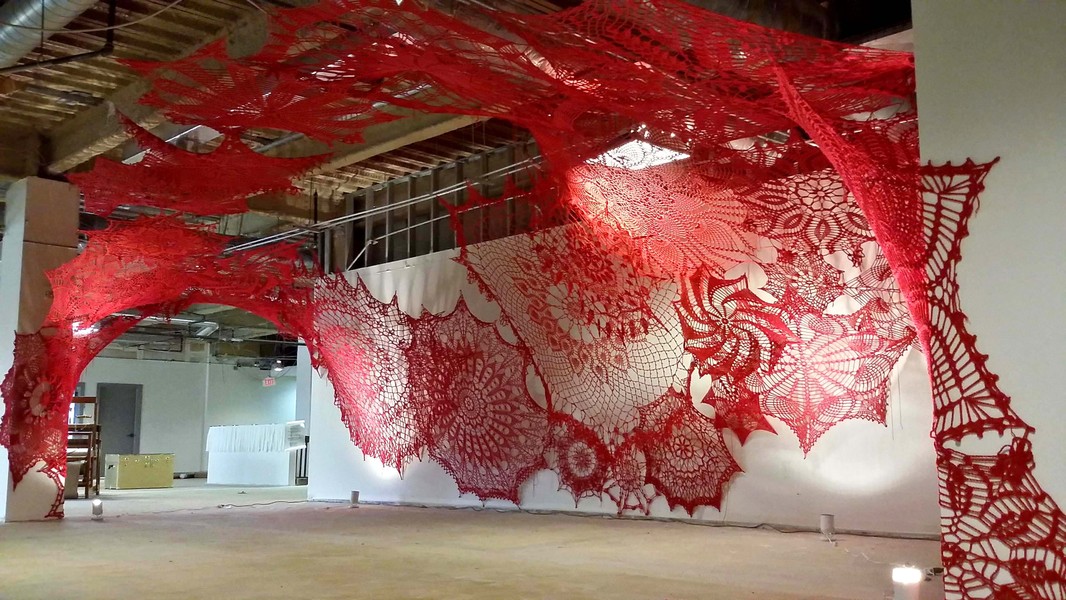Lo que sí sabemos es que a mediados del siglo XIX el croché salvó a Irlanda de lo que fue conocido como la Gran Hambruna. La expansión descontrolada de plagas dejaron al país sin su principal sustento alimenticio y económico: los cultivos de patatas. Este trágico suceso no solo se tradujo en más de 1 millón de bajas y otro millón de migraciones, también obligó a quienes permanecieron en el territorio a buscar alternativas de supervivencia. Así fue, como las monjas comenzaron a divulgar esta técnica como un modelo alternativo de subsistencia más que factible gracias a las facilidades que ofrecía (en términos modernos: trabajo en remoto y reducción de jornada laboral); y en poco tiempo, Irlanda contaba con escuelas de artesanos y cooperativas destinadas únicamente al empleo del “crochetero”, incluyendo la figura del hombre en el gran boom de esta nueva profesión.
El croché monumental de Ashley V.Blalock, o cómo dejar que la obra hable por sí sola.
Romina Llaguno
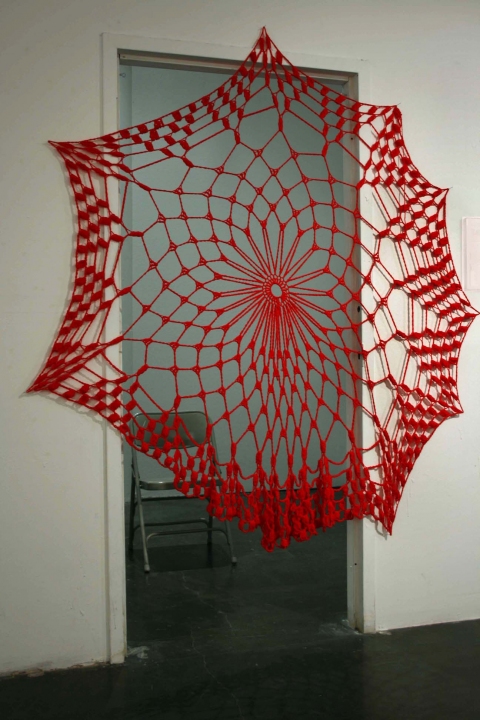
The origins and origins of crochet are not at all clear. Some documents trace its beginnings to South America more than 12,000 years ago; other historians, such as Lis Paludan, place its birth in Arabia, reaching Tibet and Spain, and consequently the rest of Europe, through the trade routes of the time; others, however, go even further and define China as the starting point.
Los orígenes y procedencia del croché no están en absoluto claros. Algunos documentos remontan los inicios en Sudamérica hace más de 12 mil años; otros historiadores, como Lis Paludan, sitúan su nacimiento a Arabia, llegando al Tíbet y España, y por consiguiente al resto de Europa, a través de las rutas comerciales de la época; otros, sin embargo, llegan aún más lejos y definen China como punto de partida.
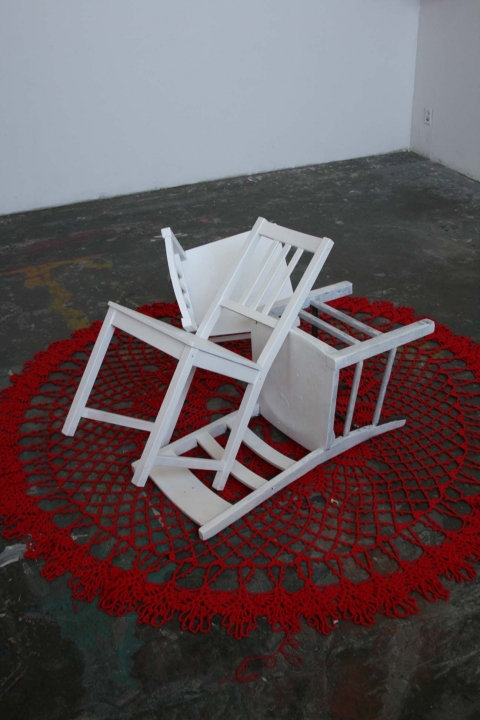

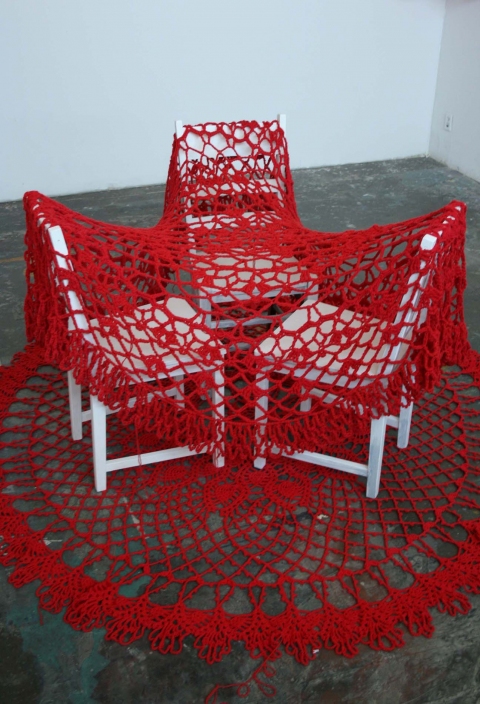
El croché salvó a Irlanda.
Crochet saved Ireland.
What we do know is that in the mid-19th century crochet saved Ireland from what was known as the Great Famine. The uncontrolled spread of pests left the country without its main food and economic lifeblood: potato crops. This tragic event not only resulted in over 1 million casualties and another million migrations, but also forced those who remained in the territory to seek alternative means of survival. Thus, nuns began to disseminate this technique as an alternative subsistence model that was more than feasible thanks to the facilities it offered (in modern terms: remote working and reduced working hours); and in a short time, Ireland had craft schools and cooperatives dedicated solely to the employment of the ‘crocheter’, including the figure of the man in the great boom of this new profession.


La artista Ashley V. Blalock ha estado creando desde 2011 instalaciones en un proceso de descontextualización de la técnica.
The artist Ashley V. Blalock has been creating installations since 2011 in a process of decontextualising technique.
Dejando a un lado la historia del croché, también conocido como crochet o ganchillo, lo cierto es que este arte guarda un valor de la tradición y del trabajo manual de la mujer incuestionables, llegando a parecer incluso herencia pura de nuestras abuelas. Y desde ese lugar, la artista Ashley V. Blalock (1978, San Diego) ha estado creando desde 2011 instalaciones en un proceso de descontextualización de la técnica con el que fusiona artesanía y bellas artes.
Tan enigmática como desconcertante, su obra a gran escala deja a un lado el aspecto viejo y tierno que llega a transmitir incluso la palabra, e impone un discurso amenazante e inquietante sobre el valor de lo doméstico. Blalock afirma: «Las blondas en sí representan un cierto deseo de mantener la apariencia de gentileza ante el mundo exterior expresada a través de la disposición de los objetos tradicionales en el ámbito doméstico». Los lugares elegidos para su instalación varían, sin importar invadir muy gentilmente galerías, escaleras o parques públicos.
Leaving aside the history of crochet, also known as crochet or crochet, the truth is that this art holds an unquestionable value of tradition and women’s manual work, even seeming to be a pure inheritance from our grandmothers. And from that place, the artist Ashley V. Blalock (1978, San Diego) has been creating installations since 2011 in a process of decontextualisation of technique that fuses craft and fine art.
As enigmatic as it is disconcerting, her large-scale work sets aside the old and tender aspect that even words can convey, and imposes a threatening and disturbing discourse on the value of the domestic. Blalock states: ‘The doilies themselves represent a certain desire to maintain the appearance of gentleness to the outside world expressed through the arrangement of traditional objects in the domestic sphere’. The places chosen for their installation vary, never mind invading very genteel verandas, staircases or public parks.


“The Yellow Wallpaper”
“The Yellow Wallpaper”
Esta manera de convertir una técnica artesanal en arte instalativo conceptual de gran tamaño (a veces las piezas pueden llegar a medir hasta los 4,5 metros), su obra parece una explosión estimulante de forma y el color (en su mayoría rojo) en el que sumergirse. Detrás de cada pieza, existe un discurso. En “The Yellow Wallpaper” Blalock crea un símil de lo que fue su experiencia personal durante la pandemia y el cuento de la escritora Charlotte Perkins Gilman del siglo XIX con el que comparte título. En él, su protagonista se sumerge en una depresión posparto que acarrea un aislamiento doméstico severo, y donde el papel amarillo de la habitación de la que no puede escapar la protagonista se convierte en un elemento clave de la historia.
Sin embargo, la reflexión más impactante no ha sido únicamente la monumentalidad y complejidad de sus instalaciones. Blalock nació y creció en San Diego, California (donde continúa residiendo actualmente). Cuenta con másters en escultura e historia del arte por diversas universidades estadounidenses y su trayectoria profesional recoge exposiciones en solitario en Nevada Museum of Art, el Lion Brand Yarn Studio de Nueva York y la Last Bookstore de Los Ángeles, y en exposiciones colectivas en el Craft in America Center, el Mingei International Museum y el Arthouse del Jones Center. Sin embargo, parece que Blalock es fiel al valor “orgánico” de su obra. Con una cuenta de instagram privada y 247 seguidores, Blalock se mantiene personalmente en el filo de la exposición digital.
This way of turning a craft technique into large-scale conceptual installation art (sometimes pieces can reach up to 4.5 metres), his work looks like a stimulating explosion of form and colour (mostly red) in which to immerse oneself. Behind each piece, there is a discourse. In ‘The Yellow Wallpaper’ Blalock creates a simile of his personal experience during the pandemic and the 19th century short story by Charlotte Perkins Gilman with which it shares its title. In it, the protagonist is plunged into a postpartum depression that leads to severe domestic isolation, and where the yellow paper of the room from which the protagonist cannot escape becomes a key element of the story.
However, the most striking reflection has not only been the monumentality and complexity of his installations. Blalock was born and raised in San Diego, California (where he still lives today). He holds master’s degrees in sculpture and art history from several American universities, and his professional career includes solo exhibitions at the Nevada Museum of Art, the Lion Brand Yarn Studio in New York and the Last Bookstore in Los Angeles, and group exhibitions at the Craft in America Center, the Mingei International Museum and the Arthouse at the Jones Center. However, Blalock seems to be true to the ‘organic’ value of his work. With a private instagram account and 247 followers, Blalock personally keeps himself on the edge of digital exposure.
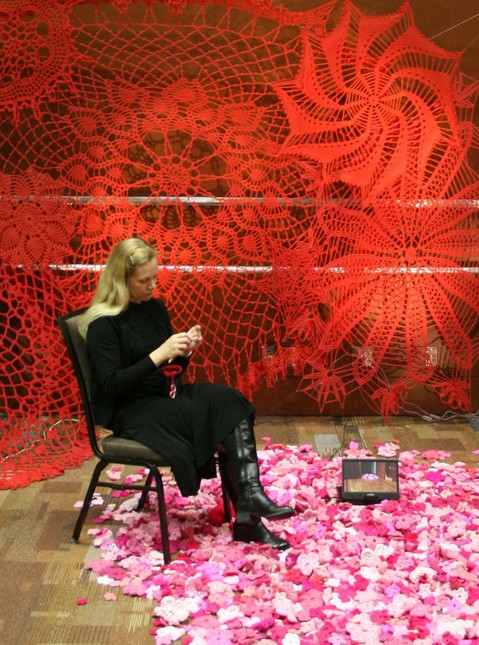

#offlineisthenewluxury
#offlineisthenewluxury
